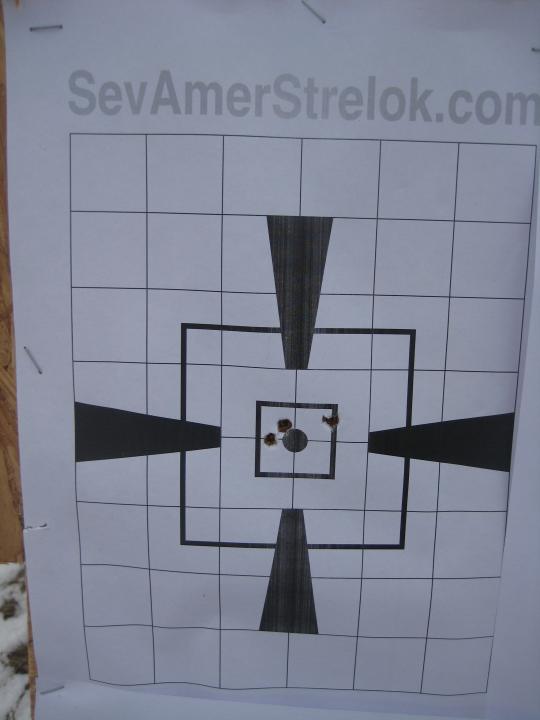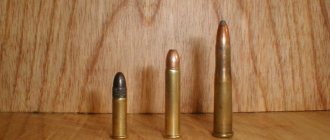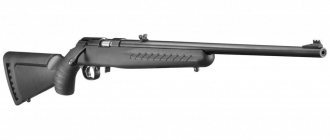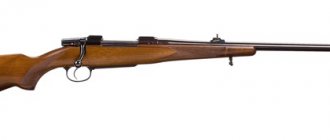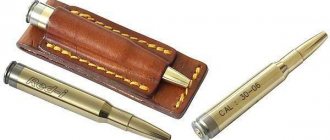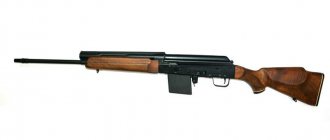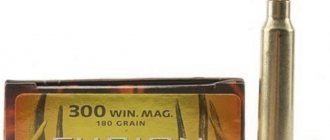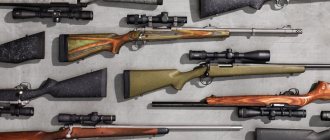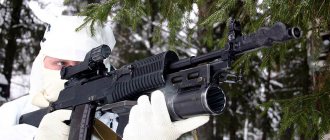Acquaintance
The 22 WMR ammunition is a low-pulse rimfire cartridge. It is very popular among civilian consumers. 5.6 mm 22 WMR caliber cartridges are intended for hunting. Also, these ammunition can be equipped with small arms units for self-defense.
You will be interested in: Internal troops of the Republic of Belarus: type of troops, structure, ranks and conditions of service
About the history of creation
The developer of the 22 WMR caliber was the American arms company Winchester Repeating Arms Company. The cartridge was designed back in 1959, but the company organized mass production in 1960. At this time, they began to manufacture 22 WMR weapons using this ammunition. Soon, other leading American arms companies began producing rifle units for this caliber. According to experts, caliber 22 WMR is the first rimfire cartridge that was mass-produced in the 19th century. Other ammunition of this type appeared only in the 20th century.
Description
You may be interested in:Space weapons: description, application, types and characteristics
22 Mag is somewhat different from other small caliber ammunition. Unlike cartridges 22 Long, 22 Short, 22 Long Rifle, etc., 22 WMR is slightly longer (26.7 mm), and its case has thick walls.
In addition, the sleeve has a larger diameter (6.1 mm). Thus, the use of this ammunition assumes the presence of increased pressure inside the cartridge. For this reason, 22 WMR cannot be equipped with weapons designed to fire other small-caliber cartridges. Otherwise, the rifle unit will become unusable and injure the owner.
At the same time, the 22 WMR caliber weapon is adapted to fire other 5.6 mm ammunition. However, in this case, the shooter may have difficulty extracting an already fired cartridge case. The fact is that if you equip a 22 WMR gun with a short cartridge, the cartridge case will swell and it will be difficult to remove it. For this reason, some manufacturers have started producing replacement drums. As a result, the owner has the opportunity to shoot small-caliber 22 Long, 22 Short, 22 Long Rifle from a gun chambered for 22 WMR caliber. You just need to install the desired drum.
.22 WMR cartridge
Cartridge .22 WMR, 1959, USA
Tactical and technical characteristics of .22 WMR Current bullet caliber, mm - 5.6 Cartridge length, mm - 34.0 Bullet weight, g - 1.9...3.2 Case length, mm - 26.7 Case neck diameter, mm - 6.1 Case base diameter, mm - 6.1 Case flange diameter, mm - 7.4 Initial bullet speed, m/s - 500...670 Bullet energy, J - 400...450
Cartridge .22 WMR (Winchester Magnum Rimfire) more often simply referred to as .22 WMR, .22 Win Mag, .22 Magnum or simply .22 Mag was developed by Winchester in 1959.
In 1960, the American companies Ruger and Smith and Wesson announced the release of a revolver chambered for this cartridge. In 1961, Winchester released the M61 lever action rifle.
.22 WMR belongs to the widespread family of “small-bore” rimfire cartridges of 5.6 mm caliber (the real caliber of all is 5.7 mm) - .22 Short, .22 Long, .22 Long Rifle, etc. Despite the fact, Although at first glance it differs from other 5.6 mm cartridges only in its longer length, it stands somewhat apart in this family.
The overall length of the cartridge is 34 mm, which exceeds the dimensions of the more popular .22 LR cartridge. The .22 WMR also has slightly larger case sizes. Its cartridge case has a slightly larger diameter and thicker walls, which allows it to withstand increased pressure when fired.
Therefore, they cannot be fired from weapons designed for cartridges of the 5.6 mm family. In principle, it is possible to do the opposite, but in this case the cartridge case of a shorter cartridge may inflate (the chamber for the .22 WMR has a diameter slightly larger than that needed for other 5.6 mm cartridges) and will be difficult to remove.
The .22 WMR cartridge is significantly more powerful than, for example, the famous .22 Long Rifle cartridge, since the amount of gunpowder in its case is approximately one and a half times greater. Its power is at the limit of power possible for rimfire cartridges. Accordingly, their firing range is significantly greater.
The muzzle velocity is very high - in some types of cartridge it reaches 600 m/s and even at a distance of 100 yards (91.4 m) is equal to the speed of a .22 Long Rifle bullet at the muzzle. The effective firing range of the .22 WMR reaches 120-130 m. At the same time, the recoil is negligibly weak, it is often not felt at all.
The .22 WMR was initially offered with a 40 grain (2.6 gram) bullet with an energy of 439 J and a bullet velocity of 580 m/s. However, .22 WMR cartridges were later developed with bullet weights of 30 and 50 grains (1.9 and 3.2 grams). In this case, the energy of the ammunition is 437 and 410 J, with a bullet speed of 670 and 500 m/s, respectively. The speed of a bullet depends significantly on the length of the weapon barrel. So the speed of a bullet when shooting from a pistol is about 460 m/s, and when shooting from a rifle – about 610 m/s.
About 22 Mag shells
Unlike other small-caliber ammunition, the 22 WMR does not use lead bullets. In 22 Magnum, the manufacturer is forced to use copper plated. The fact is that 22 WMR is much more powerful. If you shoot a cartridge with a lead unsheathed bullet at a speed of up to 600 m/s, it will fly off the rifling in the barrel channel. Also, due to high friction, it may simply melt. The heads of copper-plated 22 Magnum rounds have expansive cavities. In specialized stores you can also get special 22 WMR cartridges. Their peculiarity is that in place of the bullet there is a capsule, inside of which there is a small shot. This ammunition is effective for shooting rats and mice.
Entrance
Voice
337
A lot of different opinions have been written about the .22WMR caliber. Personally, I like this cartridge! I like the consistency, energy, and variety of types of bullets offered for this ammunition. It is designed for hunting!
In this post I will post only facts and real examples from my own experience!
The record will be updated accordingly. 
1. A tree that will be pierced by a fully coated 22 WMR bullet will not be pierced by a 16-caliber bullet fired from the same distance from a TOZ 66! (distance 10 m)
| My friend is on the line! |
| WMR bullet output. Birch! |
Pavel shot again at the same birch tree with a 16-caliber double-barreled shotgun and hit it directly at the entrance hole from the WMR. The bullet remained in the tree 
Pasha found his bullet!  |
The 16-caliber bullet was never pulled out, it was freezing! Left until spring!
I’ll try to shoot this birch in the summer... 
In the meantime, I'll add a couple more photos!
| Beautiful rifle! I love. |
Snowy Novgorod winter!  |
2. 22WMR cartridges are sold with a wide variety of bullets!
| There are two REMs on the right, two S&Bs on the left! |
| View from above! |
| Expansive 22 WMR REM in the foreground! |
3. On the issue of accuracy!
Definitely, after some little experience, I can only say one thing: you need to learn to shoot and study the MAT-PART! 
Moreover, if we talk about “getting a bunch”, then our rifles are capable of much... much more than we can reproduce ourselves at the beginning of the “shooting path”. That is, a heaped barrel will not shoot well in every “hand”!
That is, a heaped barrel will not shoot well in every “hand”! On this topic, I really like the dialogue between two of our forum members, when one says: “... I zero the client’s rifle and put all the bullets in a nickel at 100m.
On this topic, I really like the dialogue between two of our forum members, when one says: “... I zero the client’s rifle and put all the bullets in a nickel at 100m. And the client shoots - you can’t shut up your ass!”
And the client shoots - you can’t shut up your ass!”
I decided I needed to train!
And this is how I “collected” my first “minute”.
Let's go to our favorite village. We prepared the shooting area.
| Shooting table |
We prepared a stand with targets and took it to the hundred. The targets were taken from SevAmer Strelka.
| The targets are set at 100m! |
A bit of aesthetics:
| Everything is ready to shoot! |
…more!
Side view!  |
And the shooting began! Shot with expansive REM.
Sniper couple at work!  |
Steel in his eyes!!!  |
At first I shot eight times at the target! 5 full magazine and 3 to pass! On this target, in my opinion, it turned out well, at least with a CZ-tank you can shoot at a hundred meters “catching” a bullet to a bullet.
| I took aim. Eight bullets in total! The last three are indicated. |
I didn’t manage to do it again that day, but I got it done in a minute.
|
| My first "minute"! |
I'm not really bragging, but sharing my joy! Because there is nothing to brag about, but there is something to work on further. For example, I realized that my scope is not at all suitable for accurate shooting, since it has very thick marks and they cover the minute square on the target. I’ll leave time for hunting in the first place, but in the future I’ll change it, because I don’t need to save on optics.
Because there is nothing to brag about, but there is something to work on further. For example, I realized that my scope is not at all suitable for accurate shooting, since it has very thick marks and they cover the minute square on the target. I’ll leave time for hunting in the first place, but in the future I’ll change it, because I don’t need to save on optics.
4. Can’t you collect less than a minute (0.3-0.5′) with 22 WMR?
There is a very common belief that the 22WMR is not an accurate caliber! That, for example, 22 LR is more accurate. And the twists for these calibers are the same. And scatters 22WMR bullets across the paper. And it’s very difficult to assemble in less than a minute!…
I won't provide any links. Let's just check for ourselves.
So! CZ 452 ZKM Luxury version. An ordinary hunting barrel. Distance 100 m. Leepers 4x12 sight. From the bag. S&B FMJ cartridges.
| 100 m. 22 WMR . My comrade Misha is a shooter. |
Of course, “surfing” on the Internet and exchanging “experience” is a good thing, BUT you also need to shoot thoughtfully and everything will work out. 
5. Very important fact!
With a small-caliber carbine, it’s “very impressive” in bearish places! 
About the application features
If you compare the 22 WMR with the 22 Long Rifle cartridge, the Winchester is much more powerful. This is explained by the fact that the 22 WMR cartridge case holds one and a half times more powder charge, which significantly affects the combat range. For example, the projectile has a fairly high initial velocity (over 650 m/s), and the effective range varies from 180 to 200 m. Despite the high performance, when firing from a 22 WMR carbine, the recoil is very weak. Judging by the reviews of the owners, it is so minimal that it is not felt at all. The sound of the shot is not loud, which is also highly appreciated by consumers.
.22 Winchester Magnum Rimfire / .22 WMR cartridge
| .22 WMR |
The .22 Winchester Magnum Rimfire cartridge is designated: .22 Magnum / .22 Winchester Magnum / .22 WMR / 5.6 mm Winchester Magnum RF / XCR 06 027 CBR 010. The
.22 Winchester Magnum Rimfire cartridge of 5.6 mm caliber, often simply referred to as , as .22 WMR, .22 Win Mag, .22 Magnum or simply .22 Mag was developed by the American company Winchester in 1959 and quickly gained fame both at home and in Europe.
The overall length of the cartridge is 34 mm, which exceeds the dimensions of the more popular .22 LR cartridge. The .22 WMR also has much larger case sizes.
The larger dimensions of the ammunition allow the use of a larger amount of gunpowder, which in turn, unlike .22 LR, significantly increases the pressure when fired.
The .22 WMR was initially offered with a 40 grain (2.6 gram) bullet with an energy of 439 J and a bullet velocity of 580 m/s. However, .22 WMR cartridges were later developed with bullet weights of 30 and 50 grains (1.9 and 3.2 grams). In this case, the energy of the ammunition is 437 and 410 J, with a bullet speed of 670 and 500 m/s, respectively.
In 1960, the American companies Ruger and Smith and Wesson announced the release of a revolver chambered for this cartridge.
In 1961, Winchester released the M61 lever-action rifle chambered in .22 WMR.
The speed of a bullet depends significantly on the length of the weapon barrel.
So the speed of a bullet when shooting from a pistol is about 460 m/s, and when shooting from a rifle – about 610 m/s. .22 WMR
A huge number of pistols, revolvers, rifles and carbines, mainly hunting ones, designed to use this type of cartridge, were created for the .22 Magnum cartridge.
The advantages of the .22 WMR cartridge include low recoil and low noise levels when fired.
.22 WMR
The effective range of the .22 WMR cartridge is approximately 125 meters.
In addition, depending on the manufacturer, some performance characteristics of the cartridge and its ballistic characteristics vary.
The .22 Winchester Magnum Rimfire cartridge has an elongated cylindrical case. Equipped with shell or expansion bullets.
Bullets weighing 2.6 and 3.2 g have an initial velocity and muzzle energy of 615.511 m/s and 491.425 J, respectively, and at a distance of 100 m: 430.401 m/s and 245.260 J.
The optimal zeroing distance is 100 m. The excess of the flight path of a bullet weighing 2.6 and 3.2 g above the aiming line at a zeroing distance of 100 m is 4.5 and 5.0 cm.
The .22 Win Mag cartridge is one of the few side-fire cartridges that has become most often used for hunting purposes. It can be used for hunting small animals and birds: gophers, marmots, foxes, black grouse, wood grouse, geese.
Who uses 22 WMR ammunition?
According to experts, 5.6 mm cartridges are ideal for individual shooting training. The good thing about ammunition for training shooting is that it is relatively cheap. Due to the fact that beginners spend a large amount of ammunition during training, their low price is undoubtedly a plus. Due to the increased bullet speed, sports shooting was not an area in which the 22 WMR would be in demand. According to experts, in order to hit the target, the ballistic performance that can be provided by the 22 Long Rifle is sufficient, and not a more powerful cartridge.
For this reason, the manufacturer is focused primarily on hunters. It was they who realized all the strengths inherent in 22 WMR. Judging by the reviews, the Winchester is one of the few rimfire ammunition that is often used for hunting purposes. The targets for shooting are small rodents, rabbits and birds. When using 22 WMR, the hunter should be aware that at close range the projectile can damage the game carcass. If you load the weapon with a bullet that has an expansive cavity, then the muzzle energy of 22 WMR is enough to hit a coyote or jackal.
Encyclopedia of weapons
Cartridge .22 WMR, 1959, USA
Tactical and technical characteristics of .22 WMR Current bullet caliber, mm - 5.6 Cartridge length, mm - 34.0 Bullet weight, g - 1.9...3.2 Case length, mm - 26.7 Case neck diameter, mm - 6.1 Case base diameter, mm - 6.1 Case flange diameter, mm - 7.4 Initial bullet speed, m/s - 500...670 Bullet energy, J - 400...450
Cartridge .22 WMR (Winchester Magnum Rimfire) more often simply referred to as .22 WMR, .22 Win Mag, .22 Magnum or simply .22 Mag was developed by Winchester in 1959.
In 1960, the American companies Ruger and Smith and Wesson announced the release of a revolver chambered for this cartridge. In 1961, Winchester released the M61 lever action rifle.
.22 WMR belongs to the widespread family of “small-bore” rimfire cartridges of 5.6 mm caliber (the real caliber of all is 5.7 mm) - .22 Short, .22 Long, .22 Long Rifle, etc. Despite the fact, Although at first glance it differs from other 5.6 mm cartridges only in its longer length, it stands somewhat apart in this family.
The overall length of the cartridge is 34 mm, which exceeds the dimensions of the more popular .22 LR cartridge. The .22 WMR also has slightly larger case sizes. Its cartridge case has a slightly larger diameter and thicker walls, which allows it to withstand increased pressure when fired.
Therefore, they cannot be fired from weapons designed for cartridges of the 5.6 mm family. In principle, it is possible to do the opposite, but in this case the cartridge case of a shorter cartridge may inflate (the chamber for the .22 WMR has a diameter slightly larger than that needed for other 5.6 mm cartridges) and will be difficult to remove.
The .22 WMR cartridge is significantly more powerful than, for example, the famous .22 Long Rifle cartridge, since the amount of gunpowder in its case is approximately one and a half times greater. Its power is at the limit of power possible for rimfire cartridges. Accordingly, their firing range is significantly greater.
The muzzle velocity is very high - in some types of cartridge it reaches 600 m/s and even at a distance of 100 yards (91.4 m) is equal to the speed of a .22 Long Rifle bullet at the muzzle. The effective firing range of the .22 WMR reaches 120-130 m. At the same time, the recoil is negligibly weak, it is often not felt at all.
The .22 WMR was initially offered with a 40 grain (2.6 gram) bullet with an energy of 439 J and a bullet velocity of 580 m/s. However, .22 WMR cartridges were later developed with bullet weights of 30 and 50 grains (1.9 and 3.2 grams). In this case, the energy of the ammunition is 437 and 410 J, with a bullet speed of 670 and 500 m/s, respectively. The speed of a bullet depends significantly on the length of the weapon barrel. So the speed of a bullet when shooting from a pistol is about 460 m/s, and when shooting from a rifle – about 610 m/s.
The most common bullet for the .22 WMR cartridge is not a coated lead bullet, as is the case with less powerful 5.6 mm cartridges, but a copper-plated one, since at speeds above 600 m/s a non-jacketed lead bullet can break off the rifling in the barrel or melt from friction. Often .22 WMR bullets are made with an express hollow point. There are also special .22 WMR cartridges, which have a capsule with small shot instead of a bullet, which are used for shooting mice and rats.
Currently, there are a huge number of pistols, revolvers, rifles and carbines, mainly hunting ones, designed to use this type of cartridge. This cartridge has never been used in sport shooting.
The use of this cartridge is generally the same as that of other cartridges in the 5.6 mm family. This is, first of all, individual shooting training and shooting training. This is facilitated by such qualities of the cartridge as a virtual absence of recoil, a relatively quiet shot sound and low cost. But this cartridge has never been used in “real” sports shooting. Athletes did not need increased bullet speed (the ballistic performance of the .22 Long Rifle is optimal for target shooting), so the emphasis in promoting the .22 WMR cartridge on the market was initially shifted towards hunting.
It was the hunters who could fully realize the benefits of the .22 WMR. The .22 WMR cartridge is one of the few rimfire cartridges that has become commonly used for hunting purposes.
This cartridge is suitable for shooting small rodents, rabbits, and birds, but you must keep in mind that at close range the bullet can severely smash and tear the carcass of such game, especially if you take a bullet with express emptiness. The muzzle energy of this ammunition's bullet is sufficient to kill game up to and including the size of a jackal or coyote.
The advantages of the .22 WMR cartridge include low recoil and low noise levels when fired.
‹ Cartridge .22 Short Up Cartridge .223 WSSM ›
About weapons for "Winchester"
According to experts, 22 WMR can be fired from carbines, rifles and pistols, the chambers of which are adapted for this ammunition. For example, the Czech-made Varmint CZ 455 rifle unit received a lot of positive feedback.
This carbine can be used to hunt with 22 WMR and 22 LR cartridges. A weapon with an elongated forged barrel and a wooden stock. Detachable magazines are designed for 5 and 10 rounds. The material for making the stock was walnut. The receiver is equipped with a dovetail rail. Its width is 1.1 cm. Thanks to it, you can install an optical sight on the carbine. Price: 45 thousand rubles. For anyone who wants to save money, we can recommend the American-made Marlin 925 hunting carbine. A weapon with a bolt-action system and a wooden stock.
The chamber is adapted for 22 WMR caliber cartridges. Standard sights are represented by an adjustable rear sight and front sight. Additionally, the shooting unit can be equipped with an optical sight. The hunter will have to buy it separately, since the scope is not included in the package. To become the owner of this rifled semi-automatic carbine, you will have to shell out 30 thousand rubles.
Source
